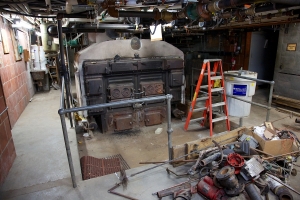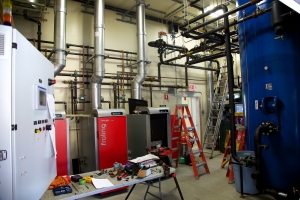You are here
Biomass Heating System
This page was las updated in 2014. If you have questions about our Biomass System, please contact Meg Fuchs, Director of Administration & Facilities.
In October 2013, the Harvard Forest converted to a new, highly efficient thermal biomass system to heat the campus's five main buildings for research and education (totaling 41,255 sq ft). All cordwood for the new system is harvested from Harvard Forest land (see land-use master plan) by the Harvard Forest Woods Crew.
A January 2014 Open House introduced the new system with a guided tour of the facility and related research sites, and remarks from leaders at Harvard University, the USDA Forest Service, the Mass. Executive Office of Energy and Environmental Affairs, and the state legislature.
- Biomass System Fact Sheet & Q&A
- Full Biomass System Specifications and Project Background
- Sustainability Initiatives at the Harvard Forest
Associated Research
Monitoring the Biomass System
- The programmable logic controller that controls the system also collects data on system temperatures, water flow, and control operation.
- A Campbell Scientific CR1000 datalogger captures temperature and flow data; reads critical system temperatures for specific locations in the biomass boiler room; records the amount of propane used by the back-up Ray-Pak boiler; and computes BTU usage, summing it on an hourly basis.
- The 3 Froeling FHG boilers are monitored by 'BoilerScope', a proprietary monitoring system developed by DCM Logic. This system provides information about the status of the boilers and graphs their performance.
- The system was extensively tested and adjusted during the first heating season (2013-2014). Data for the first full year of normal operations (2014-2015) will be available online starting in fall 2014.
Fuel Usage and GHG emissions
 Between 2006 and 2012, an average of 60 cords of wood and 11,020 gallons of oil were used each year to heat 2.5 buildings (totaling 33,723 sq ft). During that 7-year period, greenhouse gases (GHG) emitted were 288 MTCDE per year (175 from wood, 112 from oil) -- totalling 2,014 MTCDE over 7 years. Averaged over the entire building footprint, GHG emitted were 0.0085 MTCDE per square foot.
Between 2006 and 2012, an average of 60 cords of wood and 11,020 gallons of oil were used each year to heat 2.5 buildings (totaling 33,723 sq ft). During that 7-year period, greenhouse gases (GHG) emitted were 288 MTCDE per year (175 from wood, 112 from oil) -- totalling 2,014 MTCDE over 7 years. Averaged over the entire building footprint, GHG emitted were 0.0085 MTCDE per square foot.
When data become available on annual cordwood and propane use for the larger footprint of 5 buildings (41,255 sq ft) heated by the new system, they will be reported here.
Additional Measurements
Harvard Forest scientists and collaborators are now beginning to determine their research questions for the system, which include:
- What is the carbon and GHG emissions budget for a small-scale biomass heating plant, from the forest to the boiler to the atmosphere?
The Massachusetts Manomet Report (2010) and other studies have argued that large-scale heat and energy production with biomass is not "carbon neutral" due to the initial reduction in carbon sequestration associated with harvesting. However, these and other studies suggest that small-scale systems with increased efficiencies may be carbon neutral. The installation of this system with the wood source coming from Harvard Forest lands provides the opportunity to examine in detail all relevant aspects of carbon uptake, storage and release associated with small-scale heat production. - Does the purported increase in boiler efficiency lead to significant improvement in overall heating efficiency (i.e., a decrease in wood use per area of building)?
- How is carbon taken up, stored, and released in association with the biomass harvesting and heating process?
- How might viable biomass markets change landowner decision-making and resulting land-use patterns?
A suite of long-term measurements at the Harvard Forest complement our analysis of the biomass heating process:
- 3 eddy-flux towers monitor carbon exchange between the atmosphere and the forest (the EMS tower is the world's oldest continuous record of its kind)
- A meteorological station continuously monitors weather data, and posts 15-minute intervals of data in real-time online
- The 35-hectare (86-acre) ForestGEO plot contains over 100,000 woody stems, all mapped and remeasured every five years
- An array of >100 long-term study plots track forest growth and carbon dynamics
History of the Project
 From its construction in 1940, Shaler Hall and part of the Archive building were heated by a HB Smith coal burner (2.88 mBTU) that was converted to wood sometime during World War II. A back-up heating system was created by adding an oil burner in 1968 in Shaler Hall and another in 1972 for the newly built Torrey Lab. The wood boiler, which is assumed to have been 30% efficient*, was fed 3 times per day (7:30, noon, and 3:30) with 4' logs, and the oil burner ran overnight and on weekends during the heating season as well as on extremely cold days.
From its construction in 1940, Shaler Hall and part of the Archive building were heated by a HB Smith coal burner (2.88 mBTU) that was converted to wood sometime during World War II. A back-up heating system was created by adding an oil burner in 1968 in Shaler Hall and another in 1972 for the newly built Torrey Lab. The wood boiler, which is assumed to have been 30% efficient*, was fed 3 times per day (7:30, noon, and 3:30) with 4' logs, and the oil burner ran overnight and on weekends during the heating season as well as on extremely cold days.
After 8 years of planning and fundraising, in 2013, we purchased 3 Froling FHG Turbo 3000 Wood Gasification boilers (0.17 mmBTU, total .5 mmBTU) to replace the Smith wood boiler. For back-up, we purchased a Ray-Pak propane-fired secondary boiler (1.5 mmBTU/hr). In October 2013, we fired up the first of the new wood boilers and converted over to the new district heating system. This system provides heat to Shaler, Torrey Lab, and the Archives as well as two additional buildings: Community House and the renovated Pole Barn. These buildings total 41,255 sq ft, a 120% increase in the district heating system scope.
New processing equipment has also made wood production faster and safer. For 70 years, wood production involved a 10-step process, from tree felling by chainsaw to feeding 4-ft lengths of split wood into the boiler. The new system and modern processing equipment have cut this effort by 50%.
*Evaluation of Efficiency Differences Between Existing Harvard Forest Heating System and New Biomass District Heating System, Wilson Engineering Report to USDA Forest Service Wood Education and Resource Center, 5/9/10
Project Support
Funding and Project Management
- Harvard University Faculty of Arts and Sciences
- Michael Smith, Dean
- Leslie Kirwan, Dean of Administration and Finance
- Michael Lichten, Associate Dean for Physical Resources and Planning
- USDA Forest Service Northeastern Area - Wood Education and Resource Center
- Lew McCreery, Woody Biomass Coordinator
Project Design and Implementation
- Harvard Forest Woods Crew
- Wilson Engineering Services (project design)
- Research Designs, Inc.: Francis Bowles
- AFS Energy Systems
- Seaman Engineering: Kevin Seaman
- Nault Architects: Steve VanDyke


